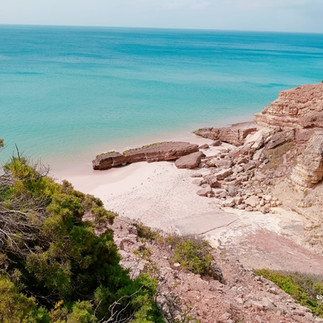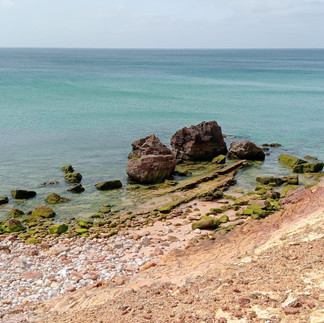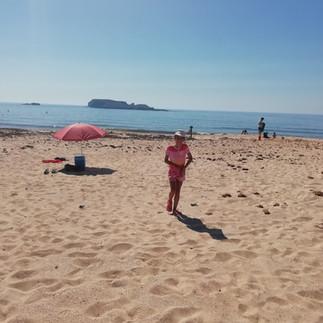Beaches of Vila do Bispo: 15 Places to Disconnect and Breathe in Nature
- Catarina Araújo

- Jun 30
- 8 min read

Vila do Bispo – A Sanctuary by the Sea
Here, at the southwestern tip of Portugal, there’s a stretch of coastline where time slows down and the landscape speaks to the soul. Located within the Southwest Alentejo and Vicentine Coast Natural Park, the beaches of Vila do Bispo are more than just strips of sand — they’re places full of stories, hidden trails, traces of ancient times, and perfect spots for a peaceful swim or a surf session.
Here, the land ends and the senses come alive. We invite you to discover 15 beaches in the municipality of Vila do Bispo, each with its own personality. Some are lifeguarded and easily accessible; others remain wild and secret.
15 beaches in Vila do Bispo to explore at your own pace
1. Praia do Burgau – a charming cove in a small fishing village
If you’re into small villages full of charm and history, Burgau is a great place to start. The beach is cosy and easy to reach, with a picturesque feel. Whitewashed houses seem to flow down to the sand, creating a truly charming setting. Even though it attracts visitors in summer, it still holds that genuine, lived-in atmosphere that makes you want to stay.
Lifeguarded beach.
2. Praia das Cabanas Velhas – quiet and peaceful between the cliffs
Less well-known, this beach is ideal if you’re looking for peace and quiet without having to hike. Surrounded by gentle cliffs, it offers a more secluded experience — perfect for unwinding. Parking is easy, and the access is direct.
Lifeguarded beach.
3. Praia da Boca do Rio – where the river meets the sea
This place is much more than a beach. Here, the Ribeira de Budens meets the Atlantic, and the entire surrounding valley holds layers of history. Walk along the Boca do Rio Biodiversity Station footpath (about 2 kilometres) and observe the birds, insects and plants typical of the region.
On the east side, you can visit the Fort of São Luís de Almádena, an ancient fortification built to protect the old fishing harbour. To the west, you'll find the Roman ruins of an ancient garum production plant - the famous condiment made from fermented fish that was exported to the Roman Empire. There are also traces of a Roman necropolis.
Paul da Lontreira, just round the corner, is a wetland rich in birdlife. You can see moorhens, cormorants, herons and even otters (if you're lucky and patient).
4. Praia da Salema – a blend of tradition and natural beauty
Salema is a fishing village that has managed to maintain its identity. The beach has good access, cafés and restaurants and even dinosaur footprints carved into the rocks - you can see them on one of the cliffs, facing west.
Here you can also try freshly grilled fish overlooking the sea at places like the Água na Boca restaurant or the Boia Bar. The calm bay makes this beach pleasant for snorkeling on calm days.
Lifeguarded beach.
5. Praia Santa – A hidden surprise
Little known, Praia Santa is a surprise between Salema and Figueira. The sand only exists at low tide. Sometimes you can even walk between Santa, Figueira and Furnas, taking advantage of the low tide.
Look out for dinosaur footprints in the surrounding rocks — this is a beach with secrets.
Unsupervised/wild beach.
6. Praia da Figueira – A beach for walkers
This beach is only accessible by footpath from the village of Figueira, making it quieter than most. The trail is well-marked, and you’ll be rewarded with a sheltered beach that feels truly removed from the world.
On the eastern hill, you’ll spot the ruins of the Figueira Fort, , a testament to the strategic importance of this coastline in ancient times, of which you can still see part of the structure. The beach is also part of the Fishermen’s Trail, a section of the Rota Vicentina coastal path that links several local beaches — a must for hikers.
Figueira beach is one of those places where silence is only interrupted by the waves. There are no tourist attractions and no reception. Bring everything with you. The isolation pays off with a peaceful swim and breathtaking views.
Unsupervised/wild beach.
7. Praia das Furnas – between rocks sculpted by the sea
Another beach that can be accessed by footpath and without support. What makes the difference here are the caves and rock formations, true natural sculptures moulded by erosion. On calm sea days, it can be a good option for snorkeling, especially near the rocks.
Unsupervised/wild beach.
8. Praia do Zavial – surf and relaxed vibes
Very popular with surfers, especially in winter, Zavial has good waves and a relaxed atmosphere. There's a restaurant right next to the beach, perfect for lunch after a swim. Despite the demand, it remains very authentic. Access is easy and parking is reasonable.
Lifeguarded beach.
9. Praia da Ingrina – A sheltered bay for snorkelling
Right next to Zavial lies Praia da Ingrina. Its semicircular bay makes it a great spot for snorkeling, especially along the rocky edges — but only on calm sea days.
There’s a car park and a restaurant right at the entrance, making it a practical beach to visit even if it’s a bit off the radar.
Lifeguarded beach.
10. Praia do Martinhal – wide, peaceful and family-friendly
Close to Sagres, Martinhal is wide, flat and has a generally calm sea. There are several islets in front of the beach, the Ilhotes do Martinhal, which create a unique environment and are interesting for observing marine life. These islets are part of the Ponta de Sagres Marine Protected Area, created to conserve sensitive habitats and rich coastal ecosystems.
The Ponta de Sagres Marine Protected Area is under regulations that prohibit extractive or destructive activities, such as fishing or irresponsible anchoring.
Non-extractive activities, such as snorkeling and free diving, are permitted provided that:
No species or natural elements are collected (shells, seaweed, etc.)
No marine life is disturbed (avoid touching fish, corals or urchins)
Contact with the seabed is avoided
The tranquillity of the nesting birds on the islets is respected.
This beach is popular with families, paddle boarders and windsurfers. There are cafés and restaurants nearby, such as the Nortada restaurant.
Lifeguarded beach.
11. Praia da Mareta – Sagres' central beach
This is Sagres' main beach. It's right in the centre, protected from the strongest winds, with good facilities and easy access.
On a geological level, it is a geosite: here you’ll find fossilised coral reefs, dune remnants, and visible layers of marine fossils, including Zoophycos burrows from ancient sea life.
Next to the beach is the Telheiro do Infante restaurant, where you can eat good grilled fish and enjoy great views.
Lifeguarded beach.
12. Praia do Tonel – the power of the Atlantic
Tonel beach is open and north-west facing, and very popular with surfers. The wind can be strong, but the scenery is impressive, with cliffs moulding the horizon.
It's right next to the Sagres Fortress and is the perfect beach for those who like the energy of the sea in its pure state. There is also a support point on the beach.
Lifeguarded beach.
13. Praia do Beliche – nestled between cliffs
Praia do Beliche is protected on both sides by tall cliffs, making it more sheltered from the wind. Access is via a long staircase, but once you’re down, you’ll find a peaceful cove perfect for a swim.
Nearby you can visit the Beliche Fortress or continue to the famous Cape Saint Vincent, mainland Europe’s southwesternmost point.
Tip: don't miss the sunset show at one of the viewpoints near Beliche beach.
Lifeguarded beach
14. Praia do Castelejo – wild and authentic
Surrounded by dark cliffs, Castelejo is one of the great postcards of the Costa Vicentina. The tide moulds the sand and, at the end of the day, the sunset paints everything golden.
This beach is known for its outcrops of dark schist and grauvaques, formed over 300 million years ago during the Carboniferous period. The tilted and folded layers are an impressive example of the intense tectonic activity that has shaped this area, one of the oldest geological units in the region. Erosion has carved unique shapes into the cliffs, creating a scene that attracts geologists and geology lovers alike.
Just above the beach, at the top of the cliffs, you'll find Torre de Aspa, the highest point on the Costa Vicentina at around 156 metres. This site is home to the ruins of an ancient watchtower, which served to guard the coast and warn of attacks or suspicious vessels. Today, it is also a geodesic landmark, used for topographical measurements. The view from the top is wide and impressive - on clear days, you can see as far as Cape St Vincent.
Those who visit Castelejo in winter or on summer mornings can be lucky enough to see the beach shrouded in a soft mist, which gives it an almost cinematic character.
Nearby there is a small environmental park with a footpath and a picnic area, ideal for having lunch in the open air before or after visiting the beach.
It's a good beach for learning to surf, much sought after by surf schools in the region.
Lifeguarded beach
15. Praia da Cordoama – the natural extension of Castelejo
Right next to Castelejo, Cordoama is a large open beach that’s ideal for walking, surfing, or simply enjoying the sound of the waves. At low tide, it’s possible to walk between the two beaches along the sand.
Don’t miss the Cordoama Viewpoint — it’s one of the most spectacular panoramas on the entire coast. Here you can watch one of the best sunsets in the region, so bring your camera.
Lifeguarded beach.
Tips for making the most of Vila do Bispo's beaches
Take water and food, especially for the beaches without support.
Wear comfortable shoes for the trails - some are slippery or rocky.
Respect the environment: take your rubbish with you and don't disturb the local fauna.
Check the tide before you go.

FAQs – Frequently Asked Questions about the beaches of Vila do Bispo
What are the most accessible beaches in Vila do Bispo?
Salema, Mareta, Burgau and Martinhal have the best access and easy parking.
What is the best surfing beach in the region?
Tonel and Zavial are the surfers' favourites.
Are there any beaches with cafés or restaurants?
Yes, for example: Zavial, Salema, Ingrina, Mareta and Martinhal.
Is it easy to park near the beaches?
On the better known ones, yes. On the wilder ones, it depends on the season and you may have to walk a bit.
Can you visit these beaches outside the high season?
Yes, and it's even better - fewer people, milder temperatures and even more tranquil landscapes.
Is there an ideal beach for families with children?
Martinhal beach, for its calmer sea and good access.
Can you visit all 15 beaches in one day?
Only if you run! The ideal is to spread them out over 3 to 5 days and take your time.
Are there any trails between some of these beaches?
The Fishermen's Trail links several beaches from Burgau to Mareta beach on the south coast.
When is the best time to visit Vila do Bispo?
May, June, September and October are great months - good weather and less tourism.
Let yourself be drawn to the call of the most authentic south
Vila do Bispo is a different Algarve - quieter, more real. Here, the beaches have not been swallowed up by resorts or turned into theme parks. After taking a dip in these waters, take the opportunity to visit the Vila do Bispo Museum, the Menhirs of Milrei, or simply explore the local cafés and restaurants.
Final tip? Come back with time. These beaches don't stop at one visit.





















































































































































































































Comments